#Millen Baird
Text

Therangertea did it again 🤣🙌🏽 PR actors in a horror/thriller movie 🧵:

The movie was hilarious in a good way 🤣 everyone should go watch it, it's like a black mirror episode with a dark comedy tone.
And yes, I was rooting for Zayto's mom lol
#therangertea#M3GAN#power rangers#kira josephson#dino fury#jen van epps#lori dungey#dino charge#beevil#ninja storm#michael saccente#junkalo#game face#millen baird#spydex#mystic force#brian aka caleb gallo was also in it which surprised me LOL#i love threads like these#megan movie
81 notes
·
View notes
Photo

Bad movie I have Megan 2022
#Megan#Allison Williams#Violet McGraw#Ronny Chieng#Amie Donald#Jenna Davis#Brian Jordan Alvarez#Jen Van Epps#Stephane Garneau-Monten#Lori Dungey#Amy Usherwood#Jack Cassidy#Michael Saccente#Samson Chan-Boon#Kira Josephson#Renee Lyons#Millen Baird#Chelsie Florence#Arlo Green#Natasha Daniel#Jaya Beach-Robertson#Cameron Randell#Clinton Randell#Marley Sharpe#Coco Poole#Mila Leith#Ruby Qereqeretabua
3 notes
·
View notes
Link
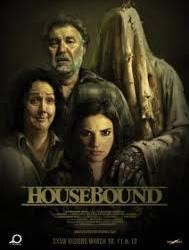
#housebound#gerard johnstone#morgana o'reilly#rima te wiata#glen-paul waru#haunted house#comedy#mystery#new zealand#ross harper#cameron rhodes#ryan lampp#mick innes#bruck hopkins#millen baird#wallace chapman#david van horn#nikki si'ulepa#horror#horror film#horror films#horror movie#horror movies#horror fan#horror fans#horror review#horror reviews#horror reviewer#film review#film reviews
0 notes
Text
Eudyptula minor
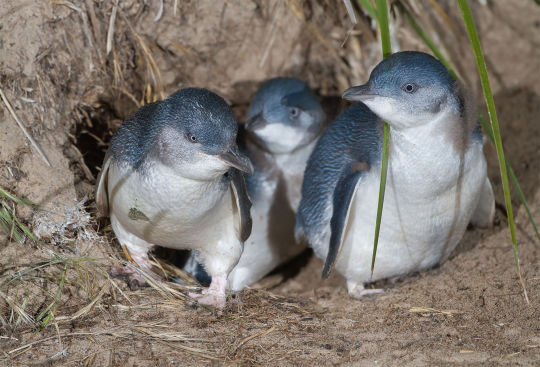
By J. J. Harrison, CC BY-SA 3.0
Etymology: Good Diver
First Described By: Bonaparte, 1856
Classification: Dinosauromorpha, Dinosauriformes, Dracohors, Dinosauria, Saurischia, Eusaurischia, Theropoda, Neotheropoda, Averostra, Tetanurae, Orionides, Avetheropoda, Coelurosauria, Tyrannoraptora, Maniraptoromorpha, Maniraptoriformes, Maniraptora, Pennaraptora, Paraves, Eumaniraptora, Averaptora, Avialae, Euavialae, Avebrevicauda, Pygostaylia, Ornithothoraces, Euornithes, Ornithuromorpha, Ornithurae, Neornithes, Neognathae, Neoaves, Aequorlitornithes, Ardeae, Aequornithes, Austrodyptornithes, Sphenisciformes, Spheniscidae
Status: Extant, Least Concern
Time and Place: From 12,000 years ago until today, in the Holocene of the Quaternary


Little Penguins are known from the coast of Australia and New Zealand
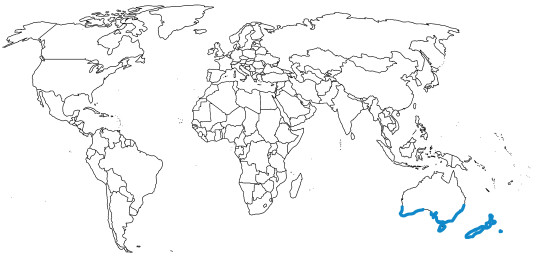
Physical Description: Little Penguins are some of the most adorable penguins alive today, and the reason is clear: they’re smol! Little Penguins range in size between 40 and 45 centimeters in length, and none weigh more than 2.1 kilograms. They are a blue-grey on their backs and white on their bellies and necks. They have very small flippers, which can be entirely blue or blue only in the center with white banding around it. They have short little tails and small feet, which are formed into lightly orange flippers. Their beaks are short and round, and either light in color or dark depending on the population. The juveniles tend to be a somewhat duller color than the adults, but usually very similar overall.

By Magnus Kjaergaard, CC BY 3.0
Diet: Little Penguins feed mainly on fish that form schools in the pelagic zone of the ocean (rather than closer to the coast). They’ll also feed on cephalopods and crustaceans.
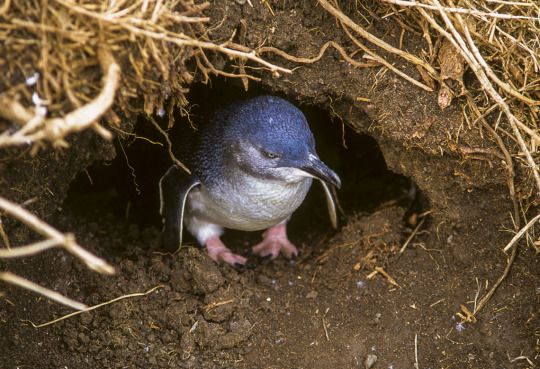
By Francesco Veronesi, CC BY-SA 2.0
Behavior: These nocturnal penguins will capture their food via pursuit-diving, mainly swimming around schools of fish in tighter and tighter circles until finally - woosh! - they dive into the middle and grab as much food as they can. In shallower water, they do pursue the fish more directly. They can dive as deep as 50 meters underwater, sometimes more - including 69 meters deep. They go up to 62 kilometers away from the nesting and sleeping colony sites, though they can usually only go a fraction of that in a single day and longer distances are reserved for multiple day trips. Females tend to forage more than the males. They feed alone, though they do forage in groups. They are extremely noisy in their colonies, making a variety of trills, brays, growls, grunts, yelping, trumpeting, and wailing sounds to one another. They do not migrate, but do stay near the breeding colony extensively during the moulting and nesting season. Juveniles will leave the colony for a large amount of time, but do eventually return to breed where they were born.
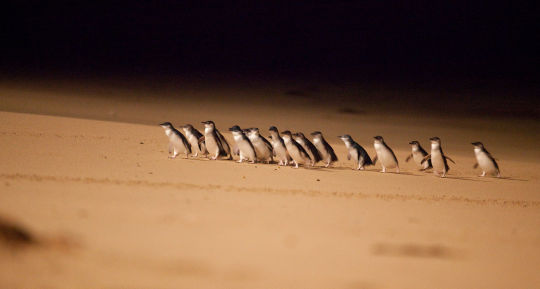
By Phillip Island Tourism, CC BY-SA 4.0
Little Penguins begin breeding in July and continue through December, though it varies from colony to colony and from year to year. They tend to stick to one nest site for their whole lives and are also fairly monogamous, though they do divorce from their partners around 76% of the time. If they are unsuccessful in raising any chicks one year, the next year they are more likely to divorce than not. The nests are made in a little bit far apart from one another in the colonie, usually a burrow in the sand lined with plant material. Usually two eggs are laid in the nest and are incubated for a little more than one month by both parents. The chicks hatch extremely fluffy and greyish-brown; they then molt to look dark brown and grey another month later. At this time young birds will form creches together for two more months, hanging out and learning from each other. They then fledge and become juveniles two more months later. They become sexually mature at two to four years of age, and can live for up to 20 years (though shorter is more common). The chicks and nesting colonies tend to feed at dusk.

By Mark Nairn, CC BY 3.0
Ecosystem: Little Penguins live mainly in sandy and rocky coasts, usually near the bases of cliffs and in sand dunes. They will spend most of their time in temperate to sub-arctic marine waters, many miles offshore. They are preyed upon by cats, dogs, rats, foxes, lizards, snakes, ferrets, stoats, seals, and some other ocean predators. They are mostly affected by introduced mammalian predators at this time.
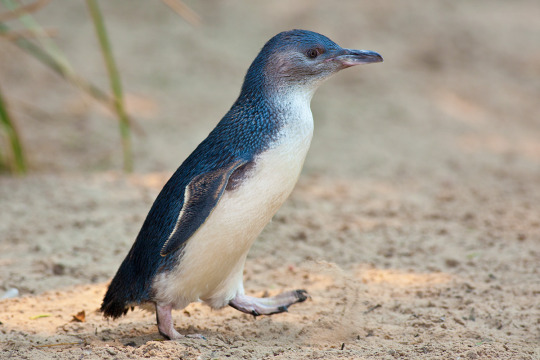
By fir0002, GFDL 1.2
Other: While Little Penguins are, overall, doing alright and are even common in terms of population management; however, a number of human-created threats are affecting certain colonies and bringing many of them to the verge of collapse. Uncontrolled hunting by domesticated dogs and cats are major causes of colony destruction, as are oil spills, fishing interactions (including being caught in nets), human interference and development, as well as cullings by humans attempting to manage populations of other birds. As such, Little Penguins are of major interest for ecological groups in order to preserve their populations in light of these threats. Fossils of this species are known from its current range from the recent ice age.
~ By Meig Dickson
Sources Under the Cut
Baird, R. F. 1992. Fossil avian assemblage of Pitfall Origin from Holocene sediments in Amphitheatre Cave (G-2), South-western Victoria, Australia. Records of the Australian Museum 44:21-44.
Banks, Jonathan C.; Mitchell, Anthony D.; Waas, Joseph R.; Paterson, Adrian M. (2002). "An unexpected pattern of molecular divergence within the blue penguin (Eudyptula minor) complex". Notornis. 49 (1): 29–38.
Bethge, P; Nicol, S; Culik, BM & RP Wilson (1997) "Diving behaviour and energetics in breeding little penguins (Eudyptula minor)". Journal of Zoology 242: 483-502.
Boessenkool, S., J. J. Austin, T. H. Worthy, P. Scofield, A. Cooper, P. J. Seddon, and J. M. Waters. 2009. Relict or colonizer? Extinction and range expansion of penguins in southern New Zealand. Proceedings of the Royal Society B 276:815-821.
Carroll, R. L. 1988. Vertebrate Paleontology and Evolution 1-698.
Chiaradia, A., Forero, M. G., Hobson, K. A., and Cullen, J. M. (2010) Changes in diet and trophic position of a top predator 10 years after a mass mortality of a key prey. – ICES Journal of Marine Science, 67: 1710–1720.
Clements, J. F., T. S. Schulenberg, M. J. Iliff, D. Roberson, T. A. Fredericks, B. L. Sullivan, and C. L. Wood. 2017. The eBird/Clements checklist of birds of the world: v2017.
Flemming, S.A., Lalas, C., and van Heezik, Y. (2013) "Little penguin (Eudyptula minor) diet at three breeding colonies in New Zealand". New Zealand Journal of Ecology 37: 199–205.
Fordyce, R. E. 1991. The Australasian marine vertebrate record and its climatic and geographic implications. In P. Vickers-Rich, J. M. Monaghan, R. F. Baird, T. H. Rich (eds.), Vertebrate Palaeontology of Australasia 1165-1190.
Grosser, Stefanie; Burridge, Christopher P.; Peucker, Amanda J.; Waters, Jonathan M. (2015-12-14). "Coalescent Modelling Suggests Recent Secondary-Contact of Cryptic Penguin Species". PLOS ONE. 10 (12): –0144966.
Grosser, Stefanie; Rawlence, Nicolas J.; Anderson, Christian N. K.; Smith, Ian W. G.; Scofield, R. Paul; Waters, Jonathan M. (2016-02-10). "Invader or resident? Ancient-DNA reveals rapid species turnover in New Zealand little penguins". Proceedings of the Royal Society B: Biological Sciences. 283 (1824): 20152879.
Littlely, Bryan (10 October 2007). "Fur seals threat to Granite Island penguins". The Advertiser. p. 23.
Martínez, I., Christie, D.A., Jutglar, F. & Garcia, E.F.J. (2019). Little Penguin (Eudyptula minor). In: del Hoyo, J., Elliott, A., Sargatal, J., Christie, D.A. & de Juana, E. (eds.). Handbook of the Birds of the World Alive. Lynx Edicions, Barcelona.
Numata, M; Davis, L & Renner, M (2000) "[Prolonged foraging trips and egg desertion in little penguins (Eudyptula minor)]". New Zealand Journal of Zoology 27: 291-298.
Rawlence, N. J., A. Kardamaki, L. J. Easton, A. J. D. Tennyson, R. P. Scofield and J. M. Waters. 2017. Ancient DNA and morphometric analysis reveal extinction and replacement of New Zealand’s unique black swans. Proceedings of the Royal Society B 284:20170876.
Rodríguez, A., Chiaradia, A., Wasiak, P., Renwick, L., and Dann, P.(2016) "Waddling on the Dark Side: Ambient Light Affects Attendance Behavior of Little Penguins." Journal of Biological Rhythms 31:194-204.
Saraux, Claire; Chiaradia, Andre; Salton, Marcus; Dann, Peter; Viblanc, Vincent A (2016). "Negative effects of wind speed on individual foraging performance and breeding success in little penguins". Ecological Monographs. 86 (1): 61–77.
Simpson, G. G. 1946. Fossil Penguins. Bulletin of the American Museum of Natural History 87(1):1-100.
Tennyson, A. J. D., and P. R. Millener. 1994. Bird extinctions and fossil bones from Mangere Island, Chatham Islands. Notornis, Supplement 41:165-178.
Tennyson, A. J. D., J. H. Cooper, and L. D. Shepherd. 2015. A new species of extinct Pterodroma petrel (Procellariiformes: Procellariidae) from the Chatham Islands, New Zealand. Bulletin of the British Ornithologists' Club 135:267-277.
van Tets, G. F., and S. O'Connor. 1983. The Hunter Island Penguin, and extinct new genus and species form a Tasmanian midden. Records of the Queen Victoria Museum, Launceston 81:1-13.
Wallis, Robert; King, Kristie; Wallis, Anne (2017). "The Little Penguin'Eudyptula minor'on Middle Island, Warrnambool, Victoria: An update on population size and predator management". Victorian Naturalist. 134 (2): 48–51.
Wiebkin, A. S. (2011) Conservation management priorities for little penguin populations in Gulf St Vincent. Report to Adelaide and Mount Lofty Ranges Natural Resources Management Board. South Australian Research and Development Institute (Aquatic Sciences), Adelaide. SARDI Publication No. F2011/000188-1. SARDI Research Report Series No.588. 97pp.
Williams, Tony D. (1995). The Penguins. Oxford, England: Oxford University Press.
Williams, M., A. J. D. Tennyson, and D. Sim. 2014. Island differentiation of New Zealand’s extinct mergansers (Anatidae: Mergini), with description of a new species from Chatham Island. Wildfowl 6:3-34.
Wood, J. R., K. J. Mitchell, R. P. Scofield, A. J. D. Tennyson, A. E. Fidler, J. M. Wilmshurst, B. Llamas and A. Cooper. 2014. An extinct nestorid parrot (Aves, Psittaciformes, Nestoridae) from the Chatham Islands, New Zealand. Zoological Journal of the Linnean Society 172:185-199.
Worthy, T. H. 1998. A remarkable fossil and archaeological avifauna from Marfells Beach, Lake Grassmere, South Island, New Zealand. Records of the Canterbury Museum 12:79-176.
Worthy, T. H., and J. A. Grant-Mackie. 2003. Late-Pleistocene avifaunas from Cape Wanbrow, Otago, South Island, New Zealand. Journal of the Royal Society of New Zealand 33(1):427-485.
#Eudyptula minor#Eudyptula#Penguin#Little Penguin#Dinosaur#Dinosaurs#Bird#Birds#Birblr#Palaeoblr#Factfile#Little Blue Penguin#Fairy Penguin#Aequorlitornithian#Ardeaen#Piscivore#Water Wednesday#Quaternary#Australia & Oceania#Blue Penguin#paleontology#prehistory#prehistoric life#biology#a dinosaur a day#a-dinosaur-a-day#dinosaur of the day#dinosaur-of-the-day#science#nature
230 notes
·
View notes
Text
Tetris reparte todas las tardes 5.000$ en premios en una competición online, ¡no te la pierdas!
Tetris reparte todas las tardes 5.000$ en premios en una competición online, ¡no te la pierdas!
Ya hicimos la reseña del sorprendente y nuevo Tetris que ensalza todo lo que este juego ha significado para la historia de los videojuegos. Desde hace ya unas semanas todas las tardes reparte 5.000 dólares en premios a todos los competidores de 16 países.
Y es que incluso se actualizó hace poco con un modo battle royale que le da su puntazo y toda la tensión para intentar subir en la tabla de líderes mundial de este gran juego casual. Vamos a explicar este nuevo modo y cómo competir todas las tardes a las 19:30h para ganar alguno de los premios para llevarte uno de 500$ por ser el mejor jugador; e incluso menos dinero si no acabas el primero…
(adsbygoogle = window.adsbygoogle || []).push({});
Cómo competir para ganar 5.000$ en Tetris
(adsbygoogle = window.adsbygoogle || []).push({});
Aquí no hay nada más que ser muy bueno jugando al Tetris para pasar esas ocho rondas de las que consta ese concurso online en el que se nos cita a miles de jugadores para intentar ser el vencedor. Y más si cabe en un Tetris del que nos quedó una muy grata sensación como os hicimos saber desde la reseña de hace unos meses.
Cuando lancemos Tetris por primera vez veremos al presentador Millen Baird en un vídeo explicando cómo funciona el concurso. Podemos activar la notificación para que unos minutos antes nos avisen de que va a comenzar la competición y que entremos a jugar.
(adsbygoogle = window.adsbygoogle || []).push({});
Hecho esto, entraremos en una partida a la que se irán sumando cientos de jugadores mientras corre el minutero indicando lo que queda para comenzar la competición. Son todos estos pa��ses los que compiten al mismo tiempo: Estados Unidos, Canadá, Reino Unido, Alemania, Irlanda, Suiza, Bélgica, Suecia, Noruega, República Sudafricana, Rusia, Chile, Australia, Nueva Zelanda y España.
Importante saber que mientras vayáis pasando ronda se os indicará como vais quedando en vuestro país. Es decir, que como nos obligan a activar el GPS para saber donde estamos jugando, podremos competir también contra otros al mismo tiempo para luego recibir premios en nuestra región.
Es decir, que no solamente vamos a intentar ganar el mejor de los premios, sino que hay más premios menores que tampoco están nada mal. Y más sabiendo que todas las tardes tendremos unos minutos de gloria en los que con práctica quizás algún día podamos ganar algo; de hecho si son 100 dólares o así, se nos notifica al día siguiente.
De hecho estos son los premios de Tetris:
Top 3: 1 jugador ganará 500 dólares
Top 100: 10 jugadores ganarán 100 dólares
Victoria: 50 jugadores ganarán 25 dólares
Ronda 5: 200 jugadores ganarán 5 dólares
Ronda 3: 150 jugadores ganarán 5 dólares
Ronda 1: 100 jugadores ganarán 5 dólares
Así que os animamos a demostrar vuestra valía jugando al Tetris para llevaros un buen dinero. Si conocéis a algún colega que se le dé bien, que no falte a la cita.
El nuevo modo Battle Royale
También nos ha sorprendido al instalar de nuevo Tetris ese nuevo modo Battle Royale y que no viene nada mal para entrenarnos para la competición. Entramos a jugar y se nos mete en una sala de 100 jugadores. Cuando pasen los segundos comenzará la partida.
Veremos en la parte superior la tabla de líderes con la mejor puntuación y como van cayendo jugadores según van terminando sus partidas. El objetivo de este battle royale es ganar puntuación para ir subiendo en la tabla de líderes mundial, aparte de poder entrenarnos para aliviar tensiones cuando entremos en la competición donde se juntan miles de jugadores a la vez.
Un modo battle royale en Tetris que pone toda la tensión al momento y que es la mejor excusa para volver a jugar a un Tetris que tiene distintos tableros y que tiene el mejor de los sabores de hace tiempo. No faltes a la cita y a entrenarte para intentar ganar todos los día suculentos premios.
Tetris® (Free, Google Play) →
Androidsis https://ift.tt/39qmRhx
0 notes
Text
'Tetris Mobile Game' Will Give $5,000 USD Cash Prizes in New "Game Show" Feature
‘Tetris Mobile Game’ Will Give $5,000 USD Cash Prizes in New “Game Show” Feature
Tetris Mobile has introduced a new competitive game show mode that rewards players with cash prizes daily within the app. The update contains four new modes, including Tetris Primetime, which is expected to take place every night within the Apple iOS and Android app. The game show will feature New Zealand actor Millen Baird as…
View On WordPress
0 notes
Text
Tetris is Becoming a New Daily Game Show with Over $1 Million in Prizes Being Given Away
July 9, 2020 11:47 AM EST
Put your Tetris skills to the test in a new iteration of the classic game called Primetime, which could see you netting some money.
Are you really, really good at Tetris? Good enough that you think you could best the competition around the world? Well, if that is the case, you now have an opportunity to put those skills to the test and potentially net yourself some cash at the same time.
The Tetris mobile game from N3TWORK has now offered a new mode called Tetris Primetime, which is essentially a new game show centered around the iconic black-based puzzler. Hosted by Millen Baird, Tetris Primetime is said to be “a breakthrough hybrid of live television and tournament play that supercharges the fun and excitement” and will see over $1 million in cash given away to players annually. The new game mode will transpire every night at 7:30pm based on the “anchor city” closest to you. For those in the United States, these two cities include New York City and Los Angeles.
“We’ve kept the gameplay that you remember, and have infused it with competition, communication, community and an incredible global, daily game show with cash prizes,” explained Neil Young, the CEO of N3TWORK. “We think Tetris has the opportunity to be bigger than ever before as fans around the world can now play in both familiar and exciting new ways.”
youtube
In addition to Tetris Primetime, another new game mode called Tetris Royale has also now joined the game, and it’s exactly what it sounds like. Much like Tetris 99 on the Nintendo Switch, Tetris Royale sees 100 players battling it out with the last player standing being crowned the winner. The idea might sound wild on paper, but if you haven’t given it a shot yet, I’d highly encourage you to do so. The battle royale format adapted to Tetris is surprisingly far more enjoyable than it has any right to be.
The Tetris mobile app is available to download right now on both iOS and Android devices.
July 9, 2020 11:47 AM EST
from EnterGamingXP https://entergamingxp.com/2020/07/tetris-is-becoming-a-new-daily-game-show-with-over-1-million-in-prizes-being-given-away/?utm_source=rss&utm_medium=rss&utm_campaign=tetris-is-becoming-a-new-daily-game-show-with-over-1-million-in-prizes-being-given-away
0 notes
Text
Kilmarnock v St Mirren
BBC coverage
How to follow:
Listen on BBC Radio 5 live and BBC local radio; text commentary on the BBC Sport website
Line-ups[1]
Match Stats[2]
Live Text[3]
Line-ups
Kilmarnock
1MacDonald
22Millen
5Broadfoot
17Findlay
18Waters
7McKenzie
8Dicker
6Power
11Jones
19Erwin
25Brophy
Substitutes
10Kiltie
12Ndjoli
13Mackay
14Higgins
21Frizzell
23Thomas
29Burke
St Mirren
1Samson
2McGinn
15Baird
24Kpekawa
3Coulson
4McGinn
28MacPherson
8Flynn
14Kirkpatrick
10Smith
18Mullen
Substitutes
5Heaton
6MacKenzie
17Kellerman
19Stewart
20Cooke
23King
25Rogers
Referee:
Steven McLean
Match Stats
Home TeamKilmarnockAway TeamSt Mirren
Possession
Home52%
Away48%
Shots
Home1
Away2
Shots on Target
Home1
Away0
Corners
Home0
Away0
Fouls
Home1
Away3
Live Text
Posted at 14'
Eamonn Brophy (Kilmarnock) wins a free kick on the left wing.
Posted at 14'
Foul by Jack Baird (St. Mirren).
Posted at 13'
Foul by Alan Power (Kilmarnock).
Posted at 13'
Cameron Smith (St. Mirren) wins a free kick in the defensive half.
Posted at 13'
Attempt saved. Lee Erwin (Kilmarnock) right footed shot from the centre of the box is saved in the centre of the goal.
Posted at 12'
Alan Power (Kilmarnock) wins a free kick in the defensive half.
Posted at 12'
Foul by Ryan Flynn (St. Mirren).
Posted at 12'
Attempt blocked. Cameron Smith (St. Mirren) right footed shot from the centre of the box is blocked.
Posted at 8'
Attempt missed. Cameron Smith (St. Mirren) right footed shot from outside the box is too high.
Posted at 4'
Alan Power (Kilmarnock) wins a free kick in the defensive half.
Posted at 4'
Foul by Ryan Flynn (St. Mirren).
Kick Off
Posted at
First Half begins.
Lineups are announced and players are warming up.
goal
References
^ Line-ups (www.bbc.co.uk)
^ Match Stats (www.bbc.co.uk)
^ Live Text (www.bbc.co.uk)
BBC Sport – Scottish
Kilmarnock v St Mirren was originally published on 365 Football
0 notes
Text
Outrageous Fortune star Siobhan Marshall turns infertility struggle into web series
By Jack van Beynen Millen Baird and Siobhan Marshall were married in 2015. The other day, Siobhan Marshall and husband Millen Baird bought a pram, filled it groceries and pushed it around a mall in Newport Beach, California. They got into an elevator with a woman who had a pram wi...
continue reading
0 notes
Photo

Bathroom selfie @millenbaird @emmettskilton @twentyoneakl #birthday #farewell #leaving #england #drinks #bathroom (x)
#Ben Barrington#Emmett Skilton#Millen Baird#The Almighty Johnsons#cast#photos#the three tallest cast members hang out
26 notes
·
View notes
Photo


220 notes
·
View notes
Text
*whispers* what do u mean u don't love Millen Baird
REALLY ACTUALLY IN LOVE WITH LANCE AT THIS POINT BYYYYYE
13 notes
·
View notes